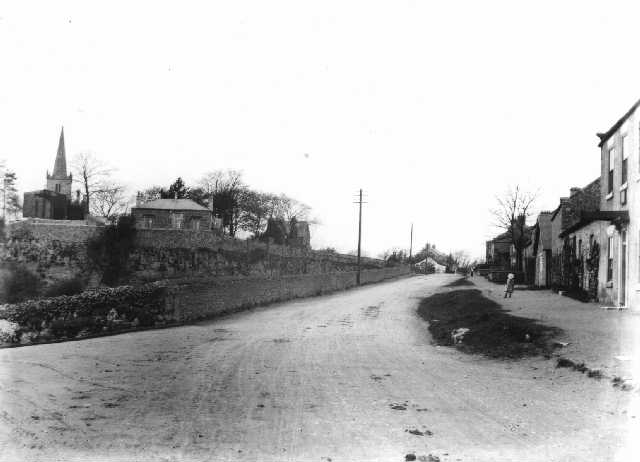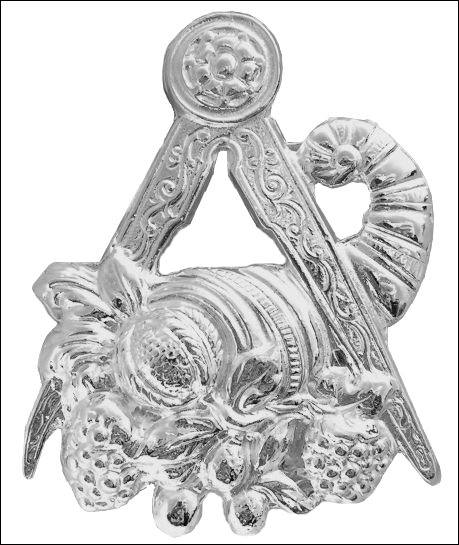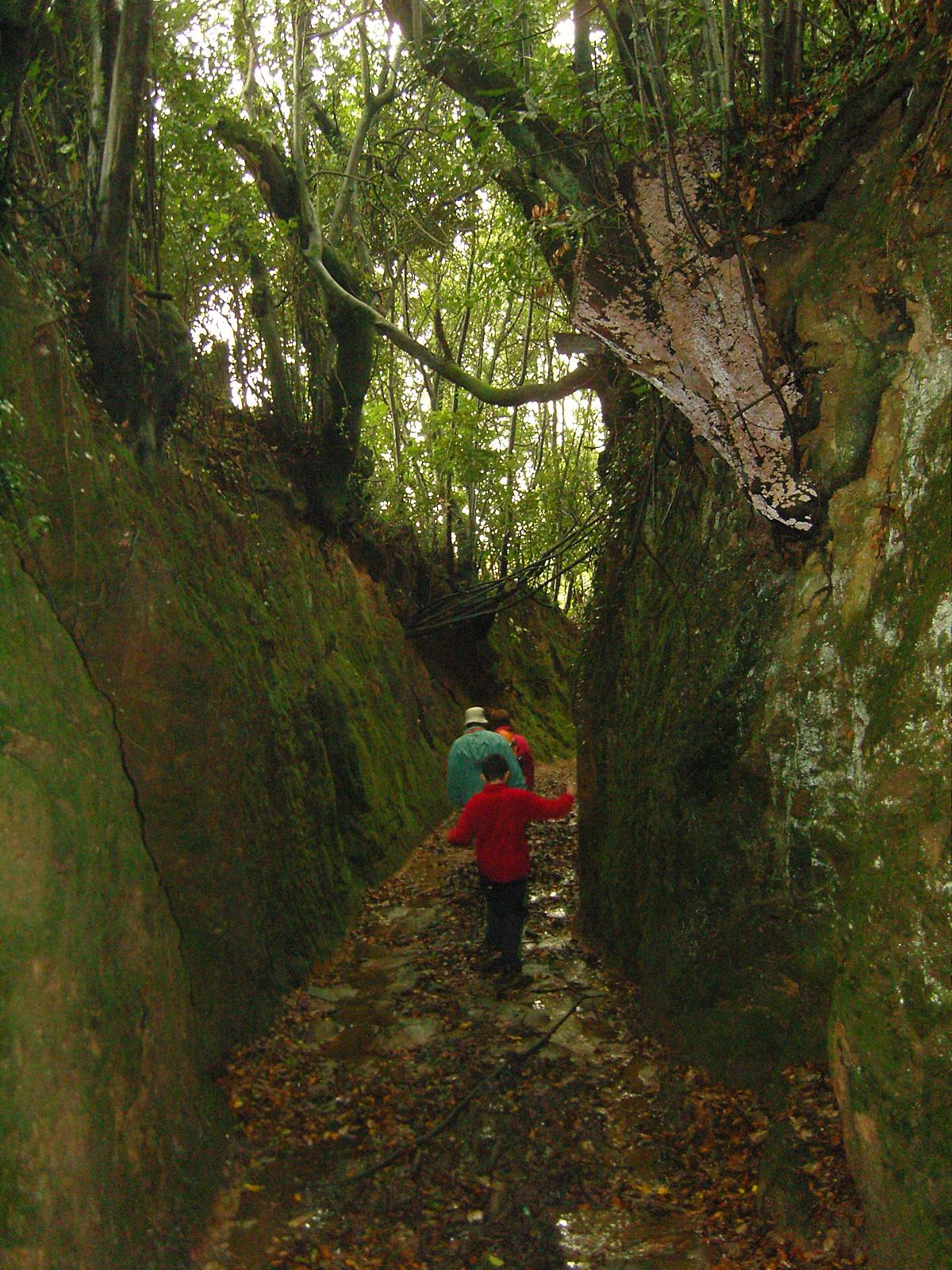|
Ulnaby
Ulnaby is an abandoned village and scheduled monument, scheduled ancient monument in the grounds of Ulnaby Hall Farm, near High Coniscliffe, County Durham, England. The toft village was occupied from the late-13th to the 16th century and temporary buildings were erected in the 19th century. Ulnaby Hall farm appears to have been built in the late-16th century, supplanting a high status Middle Ages, medieval manor house, manorial enclosure associated with the original village. It is thought that the village shrank because of the change from labour-intensive arable farming to pasture, before being abandoned and the site was subsumed into the farm as pasture. Location The site is 6.8 km north-west of Darlington, in the grounds of Ulnaby Hall Farm, between Ulnaby Lane and the B6279, near High Coniscliffe, County Durham. The earthworks cover an area of 0.16 km2 under pasture, with the actual village covering 6.6 hectares. There are ridge and furrow areas to the north and west ... [...More Info...] [...Related Items...] OR: [Wikipedia] [Google] [Baidu] |
High Coniscliffe
High Coniscliffe is a parish and village in the borough of Darlington and ceremonial county of County Durham, England. The parish includes Carlbury and Low Coniscliffe. It is part of Heighington and Coniscliffe ward, and is situated approximately west of Darlington. At the 2011 Census the population of this civil parish was 242. It is now a linear village, with most houses along the north side of the A67, but is also a doubly nucleated village as it has a village green and church on the south side of the road, and a history of a community focus at the T-junction of Ulnaby Lane and the A67, where the Methodist church and post office once were, and where a public house remains. It has always been a small village, but its history goes back to Anglo-Saxon times, and the earliest part of St Oswald's church is Norman. The Duke of Wellington pub is notable for having had a portrait of Napoleon, Wellington's defeated enemy, on its sign from 1975 to 1988. Geographical and political ... [...More Info...] [...Related Items...] OR: [Wikipedia] [Google] [Baidu] |
Carlbury
Carlbury is a hamlet (place), hamlet in the civil parishes in England, civil parish of High Coniscliffe in County Durham, in England. It is situated a few miles to the west of Darlington, on the north bank of the River Tees between Piercebridge to the west, and High Coniscliffe to the east. High and Low Carlbury once constituted a slightly larger settlement, but most of the hamlet at Low Carlbury became derelict and was demolished by the late 1940s. A few buildings remain. History In 1320 Carlbury was given by the widow of Sir John FitzMarmaduke, Sheriff of North Durham, to Thomas, 2nd Earl of Lancaster, Sir Thomas Earl of Lancaster and Leicester. After Sir Thomas was executed for treason in 1322, Carlbury went back to the widow's family and thence to the House of Neville. Carlbury consisted historically of High and Low Carlbury and was included with Summerhouse, County Durham, Summerhouse and Ulnaby in the estate of the House of Neville, Nevilles in their capacity as Earl of ... [...More Info...] [...Related Items...] OR: [Wikipedia] [Google] [Baidu] |
Darlington (borough)
The Borough of Darlington is a Unitary authorities of England, unitary authority area with Borough status in the United Kingdom, borough status in County Durham, England. Since 1997 Darlington Borough Council has been a Unitary authorities of England, unitary authority; it is independent from Durham County Council. It is named after its largest settlement, the town of Darlington, where the council is based. The borough also includes a rural area surrounding the town which contains several villages. The population of the borough at the 2021 census was 107,800, of which over 86% (93,015) lived in the built-up area of Darlington itself. Since 2016 the council has been a member of the Tees Valley Combined Authority, which has been led by the directly elected Tees Valley Mayor since 2017. The neighbouring districts are the County Durham (district), County Durham district to the north and west, Stockton-on-Tees (borough), Stockton-on-Tees to the east and North Yorkshire to the south, ... [...More Info...] [...Related Items...] OR: [Wikipedia] [Google] [Baidu] |
Bronze Age
The Bronze Age () was a historical period characterised principally by the use of bronze tools and the development of complex urban societies, as well as the adoption of writing in some areas. The Bronze Age is the middle principal period of the three-age system, following the Stone Age and preceding the Iron Age. Conceived as a global era, the Bronze Age follows the Neolithic, with a transition period between the two known as the Chalcolithic. The final decades of the Bronze Age in the Mediterranean basin are often characterised as a period of widespread societal collapse known as the Late Bronze Age collapse (), although its severity and scope are debated among scholars. An ancient civilisation is deemed to be part of the Bronze Age if it either produced bronze by smelting its own copper and alloying it with tin, arsenic, or other metals, or traded other items for bronze from producing areas elsewhere. Bronze Age cultures were the first to History of writing, develop writin ... [...More Info...] [...Related Items...] OR: [Wikipedia] [Google] [Baidu] |
Rising Of The North
The Rising of the North of 1569, also called the Revolt of the Northern Earls, Northern Rebellion or the Rebellion of the Earls, was an unsuccessful attempt by Catholicism, Catholic nobles from Northern England to depose Queen Elizabeth I of England and replace her with Mary, Queen of Scots. Background Elizabeth I of England, Elizabeth I succeeded her half-sister Mary I as queen of England in 1558. Elizabeth's accession was disputed due to the questioned legitimacy of the marriage of her parents (Henry VIII and Anne Boleyn), and Elizabeth's own questioned legitimacy due to the Second Succession Act, Act of Succession 1536. Under Henry VIII and his advisor Thomas Cromwell, power was gradually shifted from regional institutions to royal control. This course was encouraged by Elizabeth's counsellors such as William Cecil, 1st Baron Burghley, William Cecil and a policy of centralization was the approach favoured by Elizabeth herself at least in regards to the northern border region. ... [...More Info...] [...Related Items...] OR: [Wikipedia] [Google] [Baidu] |
Charles Neville, 6th Earl Of Westmorland
Charles Neville, 6th Earl of Westmorland (18 August 154216 November 1601) was an English nobleman, politician and Roman Catholic rebel leader, who led the Rising of the North against Elizabeth I in 1569. After the failure of the Rising, he fled first to Scotland but then went into exile in the Spanish Netherlands, fearing the same fate as his fellow rebellion leader, Thomas Percy, 7th Earl of Northumberland, who had been captured by the Elizabethan government and executed for treason in August 1572. Early life He was the son of Henry Neville, 5th Earl of Westmorland and Lady Anne Manners, second daughter of Thomas Manners, 1st Earl of Rutland. Career A Roman Catholic by upbringing, and allied to the Catholic Howard family, Westmorland opposed Queen Elizabeth I's Protestant policies and, in November 1569 he joined Thomas Percy, 7th Earl of Northumberland in the Northern Rebellion against the Queen. The rebels captured Durham, and held a Catholic mass. Forces loyal to the queen ... [...More Info...] [...Related Items...] OR: [Wikipedia] [Google] [Baidu] |
Steward (office)
A steward is an official who is appointed by the legal ruling monarch to represent them in a country and who may have a mandate to govern it in their name; in the latter case, it is synonymous with the position of regent, vicegerent, viceroy, Luogotenente, king's lieutenant (for Romance languages), governor, or deputy (the Roman ''Roman governor, rector'', ''prefect, praefectus'', or ''vicarius''). Etymology From Old English ''stíweard, stiȝweard'', from ''stiȝ'' "hall, household" + ''weard'' "wikt:warden, warden, keeper"; corresponding to Dutch language, Dutch: ''stadhouder'', German language, German ''Statthalter'' "place holder", a Germanic parallel to French ''lieutenant''. The Old English term ''stíweard'' is attested from the 11th century. Its first element is most probably ''stiȝ-'' "house, hall" (attested only in composition; its cognate ''stiȝu'' is the ancestor of Modern English ''sty''). Old French and Old Norse ''stívarðr'' are adopted from the Old English. T ... [...More Info...] [...Related Items...] OR: [Wikipedia] [Google] [Baidu] |
House Of Neville
The House of Neville or Nevill family (originally FitzMaldred) is a noble house of early medieval origin, which was a leading force in English politics in the Late Middle Ages. The family became one of the two major powers in northern England and played a central role in the Wars of the Roses along with their rival, the House of Percy. Origins The great Neville family traces its origins to Geoffrey “de Neville” (d.circa 1242), the son of Robert FitzMaldred and Isabel de Neville, who adopted the family name of his mother. Male line of Robert FitzMaldred The male line of the Nevilles was of native origin, and the family may well have been part of the pre-Conquest aristocracy of Northumbria. Following the Norman Conquest, most of the existing Anglo-Saxon aristocracy of England were dispossessed and replaced by a new Norman ruling elite, and although such survivals are very rare, continued landholding by native families was more common in the far north of England, includin ... [...More Info...] [...Related Items...] OR: [Wikipedia] [Google] [Baidu] |
Thomas, 2nd Earl Of Lancaster
Thomas, 2nd Earl of Lancaster ( 1278 – 22 March 1322) was an English nobleman of the first House of Lancaster of the royal Plantagenet Dynasty. He was Earl of Lancaster, Leicester, and Derby from 1296 to 1322, and Earl of Lincoln and Salisbury '' jure uxoris'' from 1311 to 1322. As one of the most powerful barons of England, Thomas was one of the leaders of the baronial opposition to his first cousin, King Edward II. Early life and, marriage Thomas was the eldest son of Edmund Crouchback and Blanche of Artois, Queen Dowager of Navarre and niece of King Louis IX of France. Crouchback was the son of King Henry III of England. Through his mother, Thomas was a half-brother of Queen Joan I of Navarre. His marriage to Alice de Lacy was not successful. They had no children together, while he fathered, illegitimately, two sons named John and Thomas. In 1317, Alice was abducted from her manor at Canford, Dorset, by Richard de St Martin, a knight in the service of John ... [...More Info...] [...Related Items...] OR: [Wikipedia] [Google] [Baidu] |
Baron Greystock
Baron Greystoke (or Greystock) is a title that has been created twice in the Peerage of England. It was first created when John de Greystok was summoned to Parliament in 1295. History John son of William de Greystok was summoned to Parliament by Edward I of England. In 1296 John's cousin Gilbert Fitzwilliam, descendant of John's aunt Joan de Graystock, died, and Gilbert's younger brother and heir, Ralph Fitzwilliam, did homage for Gilbert's lands and entered thereon. In August 1297 John obtained licence to enfeoff Ralph Fitzwilliam with the manor and whole Barony of Greystok, and with other manors and advowsons including his part of Morpeth, in fee simple, upon condition that Ralph should found a college in the church at Greystoke. Ralph, whose family were lords of Grimthorpe in the soke of Pocklington, Yorkshire, was then preparing to go abroad in the King's service, and in April 1298 he in return demised the feudal barony of Greystok and other manors for life to John (who ... [...More Info...] [...Related Items...] OR: [Wikipedia] [Google] [Baidu] |
Sunken Lane
A sunken lane (also hollow way or holloway) is a road or track that is significantly lower than the land on either side, not formed by the (recent) engineering of a road cutting but possibly of much greater age. Holloways may have been formed in various ways, including erosion by water or traffic; the digging of embankments to assist with the herding of livestock; and the digging of double banks to mark the boundaries of estates. Means of formation A variety of theories have been proposed for the origins of holloways. Different mechanisms may well apply in different cases. Erosion Some sunken lanes are created incrementally by erosion, by water and traffic. Some are ancient, with evidence of Roman or Iron Age origins, but others such as the Deep Hill Ruts in the old Oregon Trail at Guernsey, Wyoming, developed in the space of a decade or two. Where ancient trackways have lapsed from use, the overgrown and shallow marks of hollow ways through forest may be the sole evidence ... [...More Info...] [...Related Items...] OR: [Wikipedia] [Google] [Baidu] |





